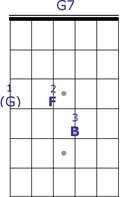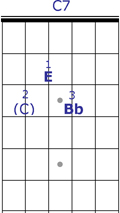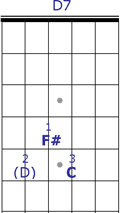This special post focuses on the dual nature of chords. After receiving great feedback from the “9th Chords and Beyond” post, I realized it would be beneficial to discuss in detail the two faces of chords: Pitch and Quality.
Separating Pitch from Quality (or type) is essential in gaining a deeper understanding of chords. It is my contention that certain notes within chords play very different roles. Some notes provide pitch information – typically the root and 5th. While other notes provide quality, or type information – which gives a chord its “sound”.
Suppose we play a game, where I give you 2 or 3 notes and ask you to choose from a list of chords and tell me which one I am playing. Let’s start with the notes C and G. Now choose from the list below:
1 3 5 7 9 13
Cma7: C E G B
Cma9: C E G B D
C7: C E G Bb
C9: C E G Bb D
C13: C E G Bb D A
Cmi7: C Eb G Bb
Cmi9: C Eb G Bb D
Based on the information I’ve given you, you know it is some type of C chord – so no problem establishing the chord’s Pitch. However, since every one of these chords contain both C and G, there is no clue to the chord’s Type, or what’s more commonly referred to as Quality. More information is needed for that.
The job of the root is to establish pitch – while the 5th typically supports the root, which is why bass players commonly play roots and 5ths on the strong beats – i.e. beats 1 and 3 in 4/4 time.
As you can see, the 3rd and 7th are needed to establish a chord’s Quality. Also, any note extensions are obviously necessary as well.
Let’s play the game again, this time adding the 3rd and 7th: if I gave you C, E, and Bb we are definitely playing a C7 chord. If we added a D, we are playing C9. For a C13 chord, you only really need the 1,3,7,13 notes: C, E, Bb, A – including the 9th is optional, as are 5ths.
Playing in a band that includes a bass player, the root is actually also optional since the bassist has that covered. So, theoretically, you could just play E and Bb, while the bass player covers the root and 5th, and it would sound like C7. In fact, doing this will result in a very clean sound, particularly for recordings.
Chord Alterations: we will cover this topic more thoroughly in a later post, but for now 5ths and 9ths are the two notes that typically get altered, that is raised or lowered by a half step. In that case, those notes would become as essential as the 3rd and 7th in establishing a chord’s Quality. Observe the highlighted “essential notes” for establishing Quality in the chords below:
1 3 5 7 9 13
C7#9: C E G Bb D#
C7#5: C E G# Bb
C13#5: C E G# Bb (D) A
Cmi7b5: C Eb Gb Bb
The 3rd, 7th, altered notes, and extensions are all essential in establishing Quality, while the root and natural 5th establish pitch.
The “sound” of a C7#9 requires the E (3rd) and Bb (7th), along with the D# (#9) – while the bassist covers the root and 5th. Normally, I would also play at least the root as well – but in this case I’m just trying to drive the point home of how notes in chords play very different roles.
Below is a typical 12-bar blues song in the key of G. We only have three chords:
1 3 5 7
G7: G B D F
C7: C E G Bb
D7: D F# A C
Theoretically, this song can be played with just two notes, the 3rd and 7th. On guitar, we can actually play the whole song with one fingering – we just need to re-voice the G7 chord, so the 7th comes before the 3rd:
G7: F B
C7: E Bb
D7: F# C
As you can see, going from G7 to C7 just requires sliding both notes down one fret – so the 7th (F) in the G7 chord becomes the 3rd (E) in the C7 chord, while the 3rd (B) in the G7 becomes the 7th (Bb) in C7.
Likewise, going up to the D7 from the G7 just requires sliding up one fret. In this case the 7th (F) in the G7 chord becomes the 3rd (F#) in the D7 chord, while the 3rd (B) becomes the 7th (C).
This is so cool – in that the 7ths and 3rds are simply swapping places – and is a powerful way of demonstrating the important roles 3rds and 7ths play in establishing chord Quality.
Here’s the chord pattern for G7 Blues:
G7 C7 G7 C7 G7 D7 C7 G7
//// //// //// //// //// //// //// //// //// //// //// ////
In summary – we’ve learned that chords have two components that play very different roles: Pitch versus Quality. The root and 5ths typically establish Pitch information, while 3rds and 7ths provide a chord’s Quality or “sound”. Any extended or altered notes also become essential in establishing a chords Quality. A clean band sound is achieved by focusing on the essential notes, eliminating any unessential notes when possible and practical.
Have fun sliding the G Blues. Until next time, I remain
Musically yours,
Al Dinardi



by Al Dinardi
05 Mar 2013 at 10:39
Editorial error – thanks for catching. I fixed it. Cmi9 would include the 9th inverval (D). Please feel free to send any other errors or comments – I always appreciate the input.
by jerbibarb
21 Jan 2013 at 09:46
why is Cm7 and Cm9 listed as the same notes?
by Al Dinardi
18 Apr 2010 at 17:49
Great question Joe. Yes, there is a such thing as 11th chords – however, 11th chords have a special quality and purpose – very unlike the dominant 7th, 9th, and 13th chords. As such, 11th chords will get separate treatment and focus these beautiful sounding chords deserve.
Additionally, there are many more embellishment type chords yet to cover: suspended 4th, 6th, 6/9, mi6, diminished, augmented, many more types of altered chords, etc. Most of these will get separate treatment as well.
Thanks again for your input. Keep hanging in there – we’re just getting started!
by Joe B
09 Apr 2010 at 16:14
Is there no such thing as an 11th. How come it’s not mentioned, or did I miss the post about that one.
by Doug Ross
07 Apr 2010 at 10:36
I think the Guitar fretboard is a playground for genius people!